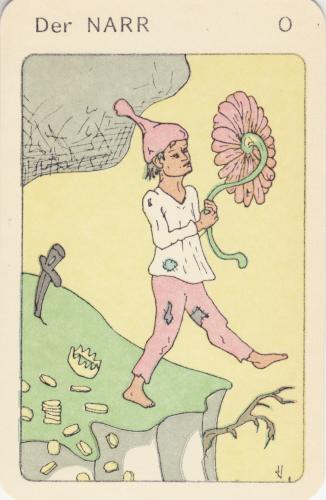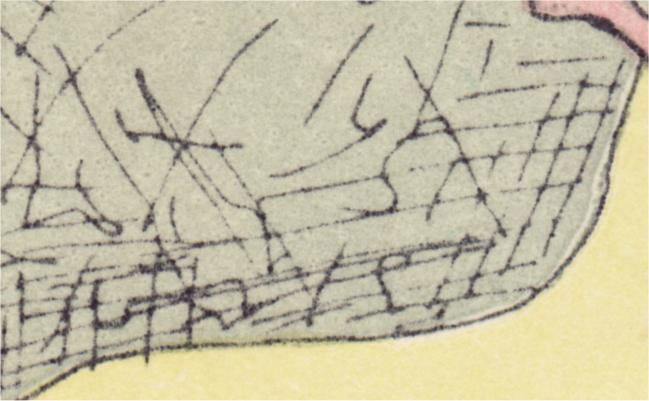 |
| Posted: Thu Dec 16th, 2010 10:47 am |
|
1st Post |
AdamMcLean
Member


|
The Linol Tarot was created by Gerhard Haack in 1988 in an edition of 150.
In most of the descriptions of this deck, including Kaplan Vol IV, it is said that these were created as Lino cuts.
Kaplan says "The deck was printed as linoleum block prints in five colours".
Having recently obtained a copy I cannot easily accept this.
The Linoleum prints that I know are made using linoleum mounted on a wooden block. This is a relief printing process where the printing area stands in relief, with the background cut away. The poor man's woodcut. Thus the lines have to be wide and strongly supported otherwise they collapse under the pressure of printing.
This does not correspond to what we see in the Linol Tarot where the lines are extremely fine.
Does anyone have any information on the Linol Tarot ?Attached Image (viewed 108 times):
 Last edited on Thu Dec 16th, 2010 10:59 am by AdamMcLean
|
|
|
| Posted: Thu Dec 16th, 2010 10:58 am |
|
2nd Post |
AdamMcLean
Member


|
Here is a detail from the cloud on the left of the Fool.
I just cannot see how such fine lines could have been created in a relief printing method, such a lino cut. These appear more like pen drawn lines. They could have been created in an intaglio printing method such as engraving or etching, but these would not have worked well for the open areas of a single colour, which would have developed ink residues as the run was printed.
There are no half-tone screen dots in the printing so that rules out conventional colour lithography.
I suspect these were printed using commercial serigraphy or screen printing, with the original pen drawings transferred onto the screen using the usual light sensitive emulsion, but with the screens for the other colours, perhaps created using stencils or drawn on the screen using a masking agent.Attached Image (viewed 107 times):

|
|
|
| Posted: Thu Dec 16th, 2010 03:32 pm |
|
3rd Post |
Quarkling
Member

| Joined: | Mon Sep 10th, 2007 |
| Location: | California USA |
| Posts: | 204 |
| Status: |
Offline
|

|
I got my copy before volume IV of the Encyclopedia was issued, so I hadn't paid much attention to it's description. However I have to agree that it is hard to believe that this is a linocut. The description at Tarot Garden says that it's a line drawing. Perhaps the description in Kaplan was somehow confused with the one for the Wollenhaupt-Brenner Tarot, which is a linocut. Otherwise it doesn't make sense.
|
|
|
| Posted: Thu Dec 16th, 2010 04:01 pm |
|
4th Post |
AdamMcLean
Member


|
The problem remains - why name it the "Linol Tarot" ?
|
|
|
| Posted: Thu Dec 16th, 2010 06:33 pm |
|
5th Post |
goldenweb
Member


|
Is it possible that the fine lines were scratched into the lino before inking the plate with a pad, and pushing the ink into the lines - as if it were an etching? I've been pretty experimental in my day, but never tried this, although it might be possible. The lino could then be cleaned carefully, leaving the ink in the scratches before printing on an etching press or using the hand pressing method with the back of a spoon or a wooden tool. The lines are very scratchy looking.
I'm not sure why anyone would want to make an intaglio print with lino, unless they didn't want to work with acid, or couldn't obtain the metal plates or other materials for etching. I'd also expect to see a slight tone on the image, unless they were 100% efficient at cleaning the flat areas of the lino before printing.
Or perhaps they simply drew on the lino with printing ink and made a single contact print before the ink dried (no cuts). I've done that on a sheet of plastic with quite interesting results. The close-ups posted don't look like that though, as there's no 'squashing' effect of the lines.
Just a couple of ideas.
Bamber Gascoigne has written a brilliant book called How to Identify Prints - a veritable bible for print collectors.
But perhaps it's called the Linol Tarot for a completely unrelated reason.
Pen Last edited on Thu Dec 16th, 2010 06:35 pm by goldenweb
|
|
|
| Posted: Thu Dec 16th, 2010 08:31 pm |
|
6th Post |
AdamMcLean
Member


|
goldenweb wrote:
Is it possible that the fine lines were scratched into the lino before inking the plate with a pad, and pushing the ink into the lines - as if it were an etching?
I doubt this would work. One would have to use some special ink that could be wicked up onto damp paper as with etchings or copperplate engravings. I think this would build up a messy ink scum which would show in the white areas.
Bamber Gascoigne has written a brilliant book called How to Identify Prints - a veritable bible for print collectors.
Yes I have a copy of this excellent survey of printing techniques.
But perhaps it's called the Linol Tarot for a completely unrelated reason.
Yes I now think this is the case. On the back of the box on which the Tarot is supplied is
Linol-Farbdruck
Gerhard Haack Kassel
I am now coming to the idea that this may have been a promotional or sample deck for a colour printing company in Kassel named "Linol-Farbdruck".Last edited on Thu Dec 16th, 2010 08:33 pm by AdamMcLean
|
|
|
| Posted: Thu Dec 16th, 2010 08:36 pm |
|
7th Post |
goldenweb
Member


|
Re-reading, I have to ask if you're saying that all 150 decks of cards were printed in the artist's studio. If so, then obviously the methods I described above wouldn't have been practical. I imagined that the original prints (however they were made) were afterwards commercially printed.
I still think those thin lines have a scratched look though.
Pen
edited to add that we cross-posted.
Last edited on Thu Dec 16th, 2010 08:37 pm by goldenweb
|
|
|
| Posted: Sun Sep 15th, 2013 04:39 pm |
|
8th Post |
Eno
Member

| Joined: | Sat Feb 13th, 2010 |
| Location: | Berlin, Germany |
| Posts: | 80 |
| Status: |
Offline
|

|
"Linol-Farbdruck" means not the black lines (which are simple line drawings), but only the big areas in five different colors were applied as linoleum block prints.
(When everything including the lines is with linoleum block print then it is called "Linolschnitt" in German.)
Last edited on Sun Sep 15th, 2013 04:42 pm by Eno
|
|
|
| Posted: Sun Sep 15th, 2013 06:53 pm |
|
9th Post |
AdamMcLean
Member


|
Thanks for clearing up this point.
|
|
|

Current time is 05:52 pm | |
|
 |
|

